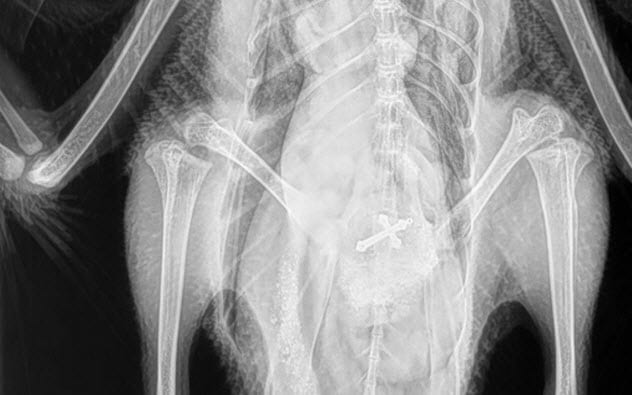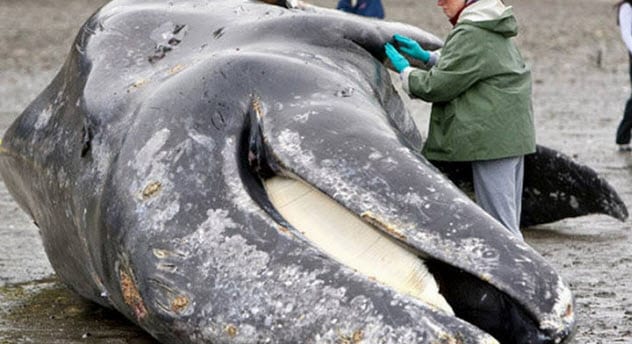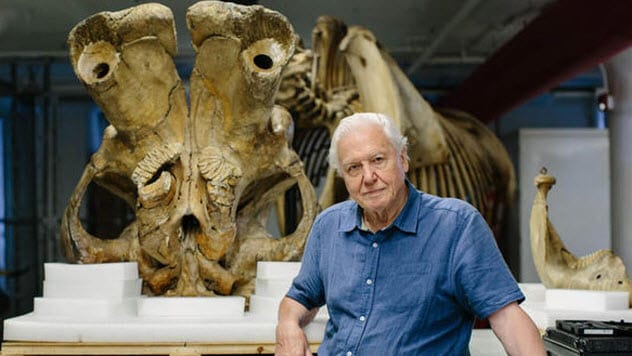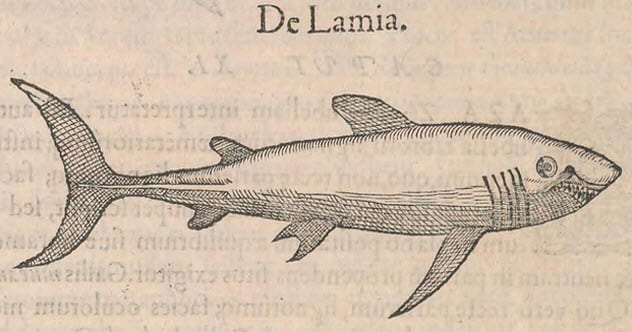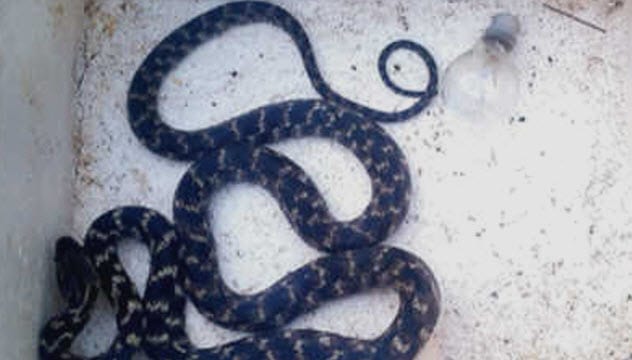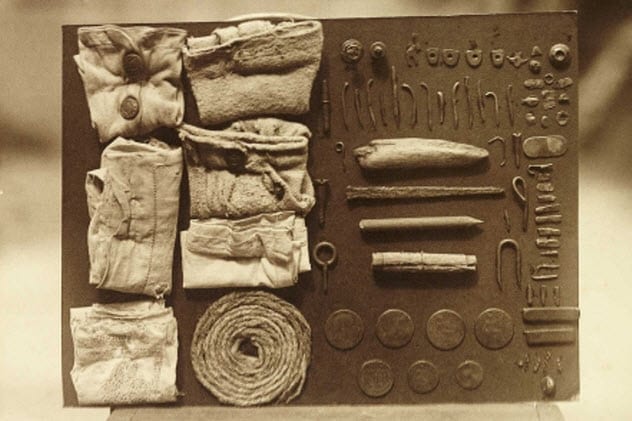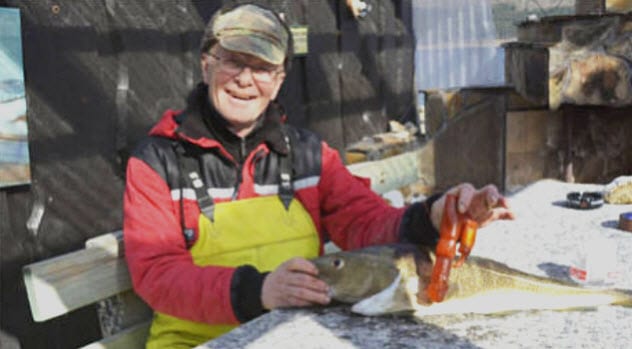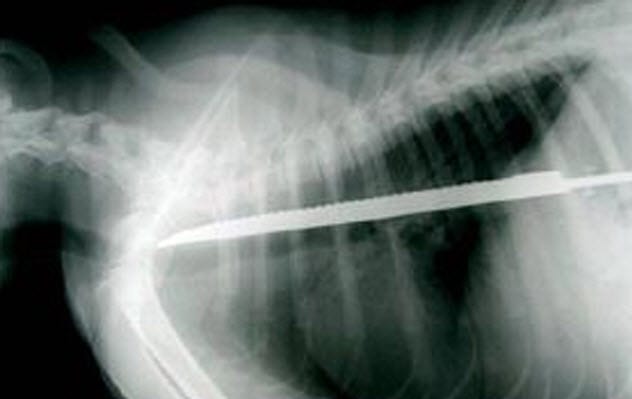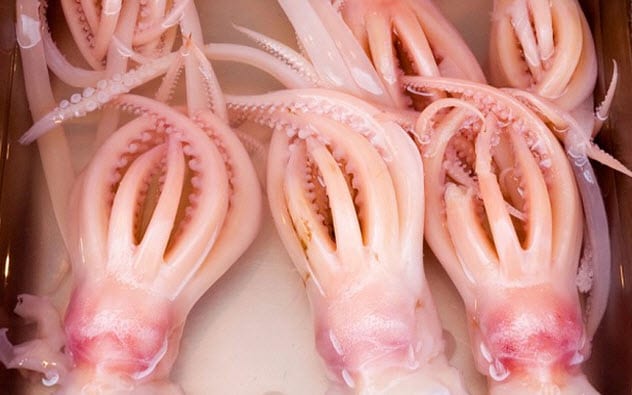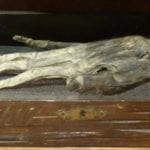Despite being unable to digest their snacks, some animals really develop a taste for inedible objects. In fact, certain animals consume so many inedible objects during their lifetime that they are believed to seek the items on purpose. It should be no surprise that one of the most common duties for veterinarians is helping animals that have consumed something they cannot digest. Just about everything easy to reach and small enough for an animal to swallow has been found within the stomachs of various creatures. These are some of the most interesting examples.
10 Goose
In Illinois in 2017, a woman brought her six-month-old pilgrim goose to a local veterinarian. The woman explained that she always wore a cross-shaped necklace around her neck. But the necklace had attracted some unexpected attention while she was cleaning the barn. Turns out that the sparkly cross was too intriguing for the goose to ignore. As the owner bent over to pick up something, the goose quickly snapped at the necklace—breaking it and swallowing the cross in the process. After an X-ray was taken, the emergency that was nicknamed “The Holy Goose” was resolved by using an endoscope to retrieve the cross.[1]
9 Whale
Due to the enormous size of whales and their proportionally massive mouths, swallowing something unintentionally is quite common for them. In 2010, marine mammal researchers found an unusually large amount of man-made debris in the stomach of one gray whale. The 11-meter-long (37 ft) whale washed ashore in West Seattle. Its stomach contained more than 20 plastic bags, surgical gloves, duct tape, a golf ball, small towels, sweatpants, and various pieces of plastic. Despite the abundance of debris, it only made up 1–2 percent of the total stomach contents. The rest was mostly algae. The whale’s death was likely unrelated to the inedible objects, but they indicated that the whale tried to feed in urban waterways. John Calambokidis from the Cascadia Research Collective noted: “It’s not a very good testament to our stewardship of the marine environment.” The whale also had cuts on its head, which could have been caused by a boat propeller. According to Cascadia: Gray whales are filter feeders that typically feed on the bottom and suck in sediment in shallow waters and filter the contents to strain out the small organisms that live there. While debris has been found in the stomachs of some previous gray whales found dead in Puget Sound, this appeared to be a larger quantity than had ever been found previously.[2]
8 Elephant
Jumbo the elephant was born in the 1860s on the border of modern-day Ethiopia and Sudan. The name “Jumbo” comes from the Swahili jumbe (“chief”). Tribesmen captured and sold the young elephant to an Italian animal dealer after slaughtering his mother for tusks. At the time, most of the elephants seen in Europe and the US came from India. As an African elephant, Jumbo was significantly larger in comparison. This became his main selling point. Millions gathered to see the gigantic elephant when he arrived at the London Zoo. Thousands of children took turns riding the elephant. Even the children of Queen Victoria and a young Winston Churchill became fans of Jumbo. However, by age 21, the famous elephant started having dangerous temper tantrums. Nobody quite understood what caused the issue, and the zoo could not risk the elephant harming anyone. Recent research with the latest technology reveals that Jumbo may have suffered an intense toothache from a monotonous diet. When the Barnum & Bailey circus in America offered £2,000 for Jumbo—a huge sum at the time—the London Zoo was eager to accept. The purchase price was quickly recouped when roughly 20 million visitors came to view Jumbo in the US in the subsequent years until his death in 1885. The elephant died at age 24, tragically young for a member of a breed that can reach age 70 in the wild. Taxidermist Carl Akeley made an interesting discovery while working to preserve the elephant’s skeleton and skin. Jumbo’s stomach contained 300 coins, a police whistle, and a bunch of keys. The coins were likely ride payments which the elephant had scooped up and swallowed. The elephant’s skeleton, which weighed more than six tons and stood 4 meters (13 ft) tall, is held at the American Museum of Natural History in New York. Jumbo inspired a Hollywood film, Walt Disney’s 1941 Dumbo, and has become a descriptive term for jumbo shrimp, jumbo eggs, and the jumbo popcorn bucket.[3]
7 Shark
Sharks are willing to take a bite out of anything they come across. This is especially true for tiger sharks, frequently referred to as the “trash cans of the ocean.” License plates, bottles, money, musical instruments, and even car tires have been found within their stomachs. However, one of the most interesting objects ever found in a shark’s stomach came from a great white shark. The object was apparently found by French physician Guillaume Rondelet, who described more than 440 species of aquatic animals. In 1554, he described the great white shark along with a story of one specimen that was found to have an entire suit of steel armor in its belly. Scientists are unsure how the “sea dog” managed to swallow the full set of armor. But thanks to Rondelet’s reputation in the scientific community, the story is believed to be true. Animal classification according to their evolutionary relationships is a fairly recent development. Previously, animals were given scientific names based on the whim of the classifier. Before Darwin, it was assumed that all animals were divinely created and naming sharks “sea dogs” was acceptable. Rondelet is considered to be the father of modern ichthyology as he was the first to describe marine animals with clearly defined anatomical principles. As he lived before Linnaeus, Rondelet did not use the Linnaean classification system. Instead, Rondelet decided to name the great white shark Canis carcharias even though Canis was not the genus of the shark and carcharias was not the species. As Rondelet was the first to describe the animal, his chosen scientific name stuck around for centuries. Linnaeus dropped the reference to dogs by naming the great white shark Squalus carcharias. Rondelet’s made-up name finally stopped being favored by the end of the 19th century. Today, the scientific name for the great white shark is Carcharodon carcharias.[4]
6 Snake
Most people see snakes as nothing more than pests. Although the average individual might put himself in danger to rescue a cute and fluffy mammal, he would likely kill a snake or avoid it entirely. One snake was lucky enough to receive help instead of a death sentence from a farmer. In 2014, a fully grown cat snake slithered into a hen coop in Uttara Kannada district in India. The hungry reptile was looking for a hen or an egg to swallow and went for the first available target—a light bulb. After its long stay in the hen coop, the bulb smelled like birds and was probably mistaken for an egg. With the bulb wedged in its belly, the snake became immobile. It hid in a corner for the next two days. The farmer realized that something weird was going on when chickens were hesitant to get back into the hen coop. He discovered the curled-up cat snake after a thorough inspection and immediately called local snake rescuers. After realizing that the snake had swallowed a light bulb, rescuers spent four hours carefully pushing the bulb out. If the bulb had broken inside, the snake would have suffered internal injuries. Every time the snake became aggressive, the rescuers had to stop and let it calm down.[5] The snake was kept in captivity for the next two days to ensure its well-being. It was released back into the wild later.
5 Turtle
A green sea turtle in Thailand was affectionately called “Om Sin” (“Piggy Bank”) when vets removed 915 coins from her stomach and intestines. She had been eating coins that tourists threw into her pond for good luck. It took four hours of surgery for the veterinarians to remove around 5 kilograms (11 lbs) of local and foreign currency. Vets from the Chulalongkorn University team could not imagine how the turtle even swallowed so many coins. The vets had to anesthetize the 25-year-old turtle and cut her shell to operate on her stomach. “If we didn’t operate on her, then she wouldn’t have been able to eat or defecate and would have soon died,” said veterinarian Nantarika Chansue. Although Om Sin was swimming and eating normally for a week, she died two weeks after the surgery. Vets stated that she was recovering well, and they planned to return her to the pond. Unfortunately, the turtle was found breathing too slowly and was taken into intensive care with a serious intestinal infection.[6] The turtle slipped into a coma and died the next day. Facebook updates of the situation received thousands of shares among the people of Thailand, who see turtles as symbols of longevity.
4 Ostrich
Ostriches mainly feed on grass, seeds, shrubs, insects, flowers, and fruits. And that is exactly what you would expect to find in the stomach of a dead ostrich. However, when one ostrich at London Zoo suddenly died around 1930, a postmortem examination revealed a surprising array of inedible objects. The bizarre find compelled a photographer working at the London Zoo to take a picture and list the contents on the back of the photo. The ostrich had swallowed three handkerchiefs, a piece of a pencil, three cotton gloves, part of a bicycle valve, part of a metal comb, an alarm clock key, 1.8 meters (6 ft) of string, the wooden center of a spool, seven coins, several small pieces of metal, one piece of wood, and a 10-centimeter (4 in) nail. Some argue that the great number of swallowed objects is a sad consequence of the bird’s urban existence, but there is another explanation. Ostriches have no teeth and ingest stones to help masticate their food in the gizzard. The bird likely swallowed the objects to help digest food. Sadly, swallowing the nail proved fatal, causing death by perforation.[7]
3 Cod
Bjorn Frilund, a 64-year-old Norwegian man with a fishing hobby, found something highly unusual in one of the fish he caught. While gutting a large cod, he felt a big lump in its belly. At first, he found two semi-digested herrings. But the lump remained, and a further search revealed a hefty orange vibrator. Although Frilund had a lot of fishing experience in the waters of his hometown of Eidsbygda, he had never heard of a fish swallowing a sex toy. The fisherman believes that the cod, weighing over 5 kilograms (11 lbs), mistook the vibrator for an octopus. Frilund said: It was totally unexpected. I had never seen anything like this before. Fish eat all kinds of different things, and the dildo looks like what the fish eat. We have a kind of multicolored octopus in Norway. Maybe the cod thought this was one of these and ate it.[8] It is amazing that such an unlikely object was even there for the fish to swallow. Frilund speculated that it may have been thrown off a cruise ship and that his chances of winning the lottery are probably greater than the chances of catching a fish that has swallowed a sex toy.
2 Dog
Due to their close proximity to humans, dogs are primary candidates for inedible object consumption. They are by far the most likely animals to end up in a veterinarian’s office because of something they ate. Almost every common household object that can fit in a dog’s mouth has been found inside a dog. In the year 2000, a six-month-old collie-Staffordshire Bull Terrier achieved something truly bewildering. The 45.7-centimeter-long (18 in) dog named Kyle swallowed a 38.1-centimeter-long (15 in) bread knife. Kyle was taken to a vet in Leeds, UK, when he started vomiting. Amazingly, there was no sign of a foreign body according to the veterinary officer Dr. Ann Draper. It took an hour to remove the knife. “It was only when it didn’t settle down that we decided to do an X-ray,” Draper explained. “The knife could have cut his internal organs to shreds at any time, and it’s a miracle he survived.”[9] This bizarre incident even resulted in a Guinness World Record for the longest solid object swallowed by a dog. After minor post-procedure swelling, the fortunate dog returned to living a normal life at home.
1 Squid
In 2013, a 0.9-meter-long (3 ft) squid was caught near Guangdong province and brought to the Jiaoling county fish market. A fishmonger was gutting the squid for a customer when his knife hit a 20-centimeter-long (8 in) live bomb. The fishmonger, Mr. Huang, quickly notified the authorities about his surprising discovery. Police suggested that the aubergine-shaped bomb weighing around 1.4 kilograms (3 lbs) might have been dropped by a fighter jet. Despite the explosive’s age and rusty exterior, it was still active and could have detonated. Police took the bomb to a safe location and performed a controlled explosion. “This sort of squid lives close to the shore and normally makes a meal of small fish and prawns,” said Mr. Huang. “Perhaps he thought the bomb was his favorite food and gulped it down. He certainly had a big belly when he was caught.”[10] Under the headline, “Squid Eats Bomb,” Guangzhou Daily reminded its readers to be cautious and always call the police if they encounter explosives.
